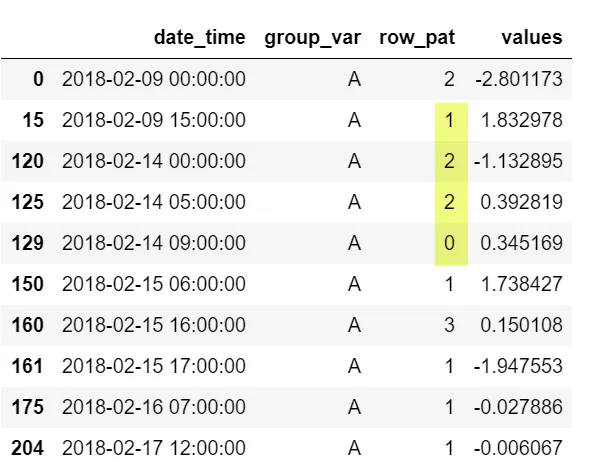我认为你有两种选择 - 更简单但较慢的解决方案或更快但更复杂的解决方案。
pat = np.asarray([1, 2, 2, 0])
N = len(pat)
df['rm0'] = (df['row_pat'].rolling(window=N , min_periods=N)
.apply(lambda x: (x==pat).all())
.mask(lambda x: x == 0)
.bfill(limit=N-1)
.fillna(0)
.astype(bool)
)
如果性能很重要,则使用strides,link中的解决方案已进行修改:
def rolling_window(a, window):
shape = a.shape[:-1] + (a.shape[-1] - window + 1, window)
strides = a.strides + (a.strides[-1],)
c = np.lib.stride_tricks.as_strided(a, shape=shape, strides=strides)
return c
arr = df['row_pat'].values
b = np.all(rolling_window(arr, N) == pat, axis=1)
c = np.mgrid[0:len(b)][b]
d = [i for x in c for i in range(x, x+N)]
df['rm2'] = np.in1d(np.arange(len(arr)), d)
另一种解决方案,感谢@divakar提供:
arr = df['row_pat'].values
b = np.all(rolling_window(arr, N) == pat, axis=1)
m = (rolling_window(arr, len(pat)) == pat).all(1)
m_ext = np.r_[m,np.zeros(len(arr) - len(m), dtype=bool)]
df['rm1'] = binary_dilation(m_ext, structure=[1]*N, origin=-(N//2))
时间:
np.random.seed(456)
import pandas as pd
from numpy.random import choice, randn
from scipy.ndimage.morphology import binary_dilation
import string
n_rows = 100000
df = pd.DataFrame({'date_time': pd.date_range('2/9/2018', periods=n_rows, freq='H'),
'group_var': choice(list(string.ascii_uppercase), n_rows),
'row_pat': choice([0, 1, 2, 3], n_rows),
'values': randn(n_rows)})
df.sort_values(by=['group_var', 'date_time'], inplace=True)
def rolling_window(a, window):
shape = a.shape[:-1] + (a.shape[-1] - window + 1, window)
strides = a.strides + (a.strides[-1],)
c = np.lib.stride_tricks.as_strided(a, shape=shape, strides=strides)
return c
arr = df['row_pat'].values
b = np.all(rolling_window(arr, N) == pat, axis=1)
m = (rolling_window(arr, len(pat)) == pat).all(1)
m_ext = np.r_[m,np.zeros(len(arr) - len(m), dtype=bool)]
df['rm1'] = binary_dilation(m_ext, structure=[1]*N, origin=-(N//2))
arr = df['row_pat'].values
b = np.all(rolling_window(arr, N) == pat, axis=1)
c = np.mgrid[0:len(b)][b]
d = [i for x in c for i in range(x, x+N)]
df['rm2'] = np.in1d(np.arange(len(arr)), d)
print (df.iloc[460:480])
date_time group_var row_pat values rm0 rm1 rm2
12045 2019-06-25 21:00:00 A 3 -0.081152 False False False
12094 2019-06-27 22:00:00 A 1 -0.818167 False False False
12125 2019-06-29 05:00:00 A 0 -0.051088 False False False
12143 2019-06-29 23:00:00 A 0 -0.937589 False False False
12145 2019-06-30 01:00:00 A 3 0.298460 False False False
12158 2019-06-30 14:00:00 A 1 0.647161 False False False
12164 2019-06-30 20:00:00 A 3 -0.735538 False False False
12210 2019-07-02 18:00:00 A 1 -0.881740 False False False
12341 2019-07-08 05:00:00 A 3 0.525652 False False False
12343 2019-07-08 07:00:00 A 1 0.311598 False False False
12358 2019-07-08 22:00:00 A 1 -0.710150 True True True
12360 2019-07-09 00:00:00 A 2 -0.752216 True True True
12400 2019-07-10 16:00:00 A 2 -0.205122 True True True
12404 2019-07-10 20:00:00 A 0 1.342591 True True True
12413 2019-07-11 05:00:00 A 1 1.707748 False False False
12506 2019-07-15 02:00:00 A 2 0.319227 False False False
12527 2019-07-15 23:00:00 A 3 2.130917 False False False
12600 2019-07-19 00:00:00 A 1 -1.314070 False False False
12604 2019-07-19 04:00:00 A 0 0.869059 False False False
12613 2019-07-19 13:00:00 A 2 1.342101 False False False
In [225]: %%timeit
...: df['rm0'] = (df['row_pat'].rolling(window=N , min_periods=N)
...: .apply(lambda x: (x==pat).all())
...: .mask(lambda x: x == 0)
...: .bfill(limit=N-1)
...: .fillna(0)
...: .astype(bool)
...: )
...:
1 loop, best of 3: 356 ms per loop
In [226]: %%timeit
...: arr = df['row_pat'].values
...: b = np.all(rolling_window(arr, N) == pat, axis=1)
...: c = np.mgrid[0:len(b)][b]
...: d = [i for x in c for i in range(x, x+N)]
...: df['rm2'] = np.in1d(np.arange(len(arr)), d)
...:
100 loops, best of 3: 7.63 ms per loop
In [227]: %%timeit
...: arr = df['row_pat'].values
...: b = np.all(rolling_window(arr, N) == pat, axis=1)
...:
...: m = (rolling_window(arr, len(pat)) == pat).all(1)
...: m_ext = np.r_[m,np.zeros(len(arr) - len(m), dtype=bool)]
...: df['rm1'] = binary_dilation(m_ext, structure=[1]*N, origin=-(N//2))
...:
100 loops, best of 3: 7.25 ms per loop

